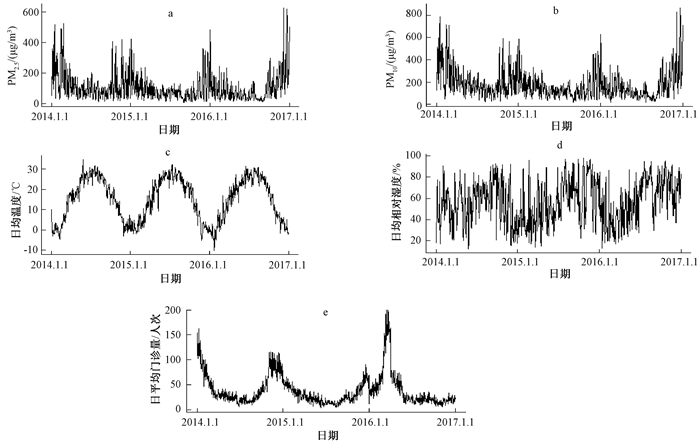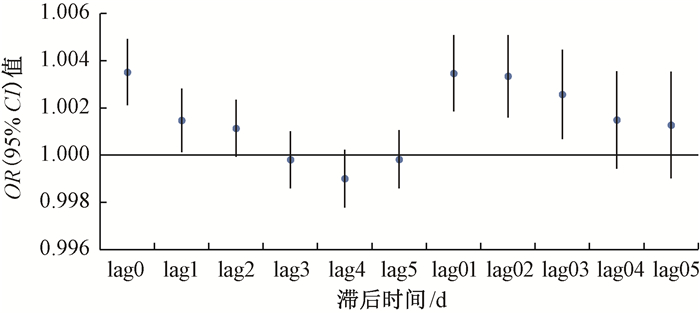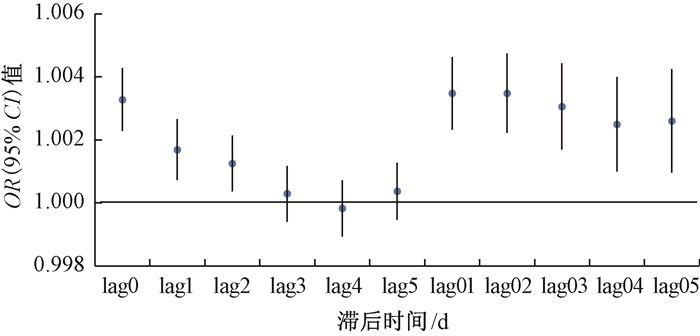2. 河北省疾病预防控制中心
空气污染作为人类健康的主要威胁,已经成为全球关注的问题[1-3]。石家庄市经济发展迅速,伴随着工业化、城镇化的不断发展,空气质量不断恶化,从2013年开始,每年都位于全国空气质量排名的后十位[4]。
急性下呼吸道感染是气管、支气管、肺组织发生的急性感染,主要表现为急性气管炎、急性支气管炎和肺炎,已经成为我国儿童死亡的主要因素[5-6]。近年来,国内外很多研究表明PM2.5、PM10是呼吸系统疾病的重要触发因素[7-12],但对儿童急性下呼吸道感染的关注却相对较少,陈浪等[13]和张芳源[14]的研究仅分析了石家庄市大气颗粒物与儿童呼吸系统疾病的关系。本研究基于石家庄市2014—2016年空气质量监测数据、气象监测数据以及河北省儿童医院急性下呼吸道感染的日门诊量数据,采用经典的广义可加模型(GAM)探讨PM2.5(微粒直径≤2.5 μm)和PM10(微粒直径≤10 μm)对儿童急性下呼吸道感染的影响,为其预防提供参考。
1 材料与方法 1.1 数据来源空气质量监测数据:从石家庄市8个空气质量监测站收集2014年1月1日—2016年12月31日的空气质量监测数据,并从中提取PM10、PM2.5、NO2、SO2和CO的日平均浓度。气象监测数据:同期的气象监测数据源于石家庄市气象局,气象因素包括日平均温度、最高温度、最低温度、日平均相对湿度、最大湿度、最小湿度、日平均气压、最高气压、最低气压、降水量等。本研究采用其中的日平均温度和日平均相对湿度数据。医院门诊数据:收集同期河北省儿童医院的内科门诊数据,根据国际疾病分类(ICD-10)编码,选取呼吸系统疾病(J00~J99)中的急性下呼吸道感染(J20~J22)的日门诊量数据。
1.2 数据处理在R软件的mtsdi包中,采用EM+Spline算法对8个空气质量监测站收集到的数据进行缺失值处理[15]。
1.3 分析方法本研究采用经典的Poisson分布的广义可加模型分析PM2.5和PM10对急性下呼吸道感染日门诊量的滞后效应。相对于石家庄市儿童总体来说,每日因急性下呼吸道感染去医院门诊就诊是小概率事件,近似服从Poisson分布,因此,本研究在排除时间趋势、星期几效应、国家法定节假日效应及气象等混杂因素的基础上,将PM10、PM2.5、NO2、SO2和CO作为线性变量引入模型,分析PM2.5和PM10对急性下呼吸道感染日门诊量的影响。GAM模型如下[16-17]:
| $ \begin{array}{l} \log \left[ {E\left( {{Y_k}} \right)} \right] = \\ \alpha + DOW + Holiday + {\beta _j}{X_k} + s\left( {time, df} \right) + s\left( {{Z_k}, df} \right) \end{array} $ | (1) |
式中:E(Yk)—响应变量,即在第k日的急性下呼吸道感染日门诊人数的预期值;
α—截距;
DOW—每周天数,用于控制短期波动;
Holiday—分类变量,周末及国家法定节假日时取值为1,其他取值为0,用于控制因假期休息导致的医院门诊量周期性波动;
βj—回归系数;
Xk—在第k日污染物的平均浓度;
S—三次平滑样条函数;
time—日期;
df—自由度;
Zk—k日的气象因素。
参考其他研究,选择df=7控制时间趋势,df=6和df=3分别控制温度和湿度的影响[11, 18]。
1.4 统计分析采用SPSS 22.0对相关数据进行统计描述,首先经过Kolmogorov-Smirnov检验发现PM2.5、PM10的日平均浓度以及日均温度、日均相对湿度、日均门诊量均不服从正态分布,因此采用中位数M和四分位数(P25、P75)进行描述。采用R软件的psych和mgcv软件包进行时序图的绘制和广义可加模型的拟合。以P < 0.05判定差异具有统计学意义。
2 结果 2.1 描述性分析 2.1.1 空气质量数据描述石家庄市2014年1月1日—2016年12月31日PM10、PM2.5、NO2、SO2和CO的日平均浓度分别为142 μg/m3、80.2 μg/m3、47.0 μg/m3、36.6 μg/m3和1.07 mg/m3(表 1)。在《环境空气质量标准》(GB 3095-2012)[19]中,PM10、PM2.5、NO2、SO2和CO的二级标准限值分别为70.0 μg/m3、35.0 μg/m3、40.0 μg/m3、60.0 μg/m3和4.00 mg/m3。除CO外其他四种污染物的日平均浓度均超标。从天数上看,3年(共1 096 d)期间,PM10、PM2.5、NO2、SO2和CO分别超标966、902、665、303和63 d,根据超标率(%)的计算公式(超标天数/总天数×100%),可以得出5种污染物的污染程度:PM10>PM2.5>NO2>SO2>CO。3年期间,PM2.5和PM10均呈现冬春季节高,夏秋季节低的趋势(图 1a、图 1b)。
| 指标名称 | Min | P25 | M | P75 | Max |
| 污染物指标 | |||||
| PM10/(μg/m3) | 17.0 | 88.6 | 142 | 222 | 867 |
| PM2.5/(μg/m3) | 6.29 | 43.3 | 80.2 | 130.7 | 625 |
| NO2/(μg/m3) | 8.71 | 33.0 | 47.0 | 68.5 | 188 |
| SO2/(μg/m3) | 3.33 | 18.7 | 36.6 | 66.1 | 307 |
| CO/(mg/m3) | 0.05 | 0.71 | 1.07 | 1.73 | 10.5 |
| 气象指标 | |||||
| 平均温度/℃ | -10.2 | 4.50 | 16.6 | 24.5 | 34.7 |
| 平均相对湿度/% | 12.2 | 39.7 | 57.0 | 72.2 | 98.0 |
| 儿童急性下呼吸道感染日门诊量/(人次/d) | 3 | 18 | 27 | 48 | 200 |

|
| 注:a 2014—2016年石家庄市PM2.5随时间变化趋势图;b 2014—2016年石家庄市PM10随时间变化趋势图;c 2014—2016年石家庄市日均温度随时间变化图;d 2014—2016年石家庄市日平均相对湿度随时间变化图;e 2014—2016年河北省儿童医院急性下呼吸道感染的门诊量随时间变化图 图 1 2014—2016年石家庄市PM2.5、PM10和温度、湿度以及儿童急性下呼吸道感染的门诊量变化趋势图 |
2.1.2 气象因素描述
研究期间,石家庄市的日平均温度为16.6 ℃,最高34.7 ℃,最低-10.2 ℃;日平均相对湿度57.0%,范围是12.2%~98.0%(表 1)。3年间日平均温度的变化规律是7月份高峰,1月份谷底(图 1c),日平均相对湿度随时间的变化趋势则为夏秋高、冬春低(图 1d)。
2.1.3 儿科日均门诊量变化对研究期间河北省儿童医院内科门诊中急性下呼吸道感染的日门诊量进行统计描述,最小为3人次/d,最大为200人次/d,平均27人次/d(表 1)。日门诊量的变化趋势是冬春季较高,夏秋季较低(图 1e)。
2.2 PM2.5和PM10对儿童急性下呼吸道感染日门诊量的滞后效应分析 2.2.1 单污染物GAM分析控制日均温度、日均相对湿度以及时间趋势、假期效应和星期几效应的影响后,PM2.5在lag0、lag1 d和累积lag01、lag02、lag03 d对儿童急性下呼吸道感染日门诊量的影响有统计学意义,OR(95%CI)值分别为1.003 5(1.002 1,1.004 9)、1.001 5(1.000 1,1.002 8)和1.003 5(1.001 9,1.005 1)、1.003 3 (1.001 6,1.005 1)、1.002 6(1.000 7,1.004 5);PM10在lag0、lag1、lag2 d和累积lag01~lag05 d对儿童急性下呼吸道感染日门诊量的影响有统计学意义,OR(95%CI)值分别为1.003 3(1.002 3,1.004 3)、1.001 7(1.000 7,1.002 7)、1.001 3(1.000 4,1.002 1)和1.003 5(1.002 3,1.004 6)、1.003 5(1.002 2,1.004 7)、1.003 1(1.001 7,1.004 4)、1.002 5(1.001 0,1.004 0)、1.002 6(1.001 0,1.004 2)。PM2.5在暴露当天、累积滞后1 d以及PM10在累积滞后1 d、2 d对日门诊量的影响最大,OR值均为1.003 5,即PM2.5或PM10浓度每增加10 μg/m3,儿童急性下呼吸道感染的日门诊量增加0.35%;总体上PM10的单日滞后效应和累积滞后效应略高于PM2.5(图 2和图 3)。

|
| 图 2 PM2.5的滞后效应与急性下呼吸道感染日门诊量的OR值 |

|
| 图 3 PM10的滞后效应与急性下呼吸道感染日门诊量的OR值 |
2.2.2 多污染物GAM分析
PM2.5的多污染物模型分析显示仅在调整SO2后模型具有统计学意义(P < 0.001),OR(95%CI)为1.004 2(1.002 3,1.006 0),即PM2.5的日均浓度每增加10 μg/m3,日门诊量增加0.42%,比PM2.5的单独效应增加了0.07%;PM10的多污染物模型分析结果表明将SO2引入模型时效应最大,OR(95%CI)为1.004 3(1.003 0,1.005 7),即PM10的日均浓度每增加10 μg/m3,日门诊量增加0.43%,较其单独效应增加了0.10%(表 2)。
| 目标污染物 | 模型 | 污染物 | β | SE | Z | P | OR(95%CI) |
| PM2.5 | 单污染物 | PM2.5 | 0.000 351 | 0.000 071 | 4.912 | <0.001* | 1.003 5(1.002 1,1.004 9) |
| 双污染物 | PM2.5+NO2 | -0.000 003 | 0.000 122 | -0.022 | 0.982 7 | 1.000 0(0.997 6,1.002 4) | |
| PM2.5+CO | -0.000 031 | 0.000 148 | -0.212 | 0.832 1 | 0.999 7(0.996 8,1.002 6) | ||
| PM2.5+SO2 | 0.000 418 | 0.000 094 | 4.459 | <0.001* | 1.004 2(1.002 3,1.006 0) | ||
| 三污染物 | PM2.5+NO2+CO | -0.000 147 | 0.000 155 | -0.948 | 0.342 9 | 0.998 5(1.001 6,0.995 5) | |
| PM2.5+NO2+SO2 | 0.000 010 | 0.000 122 | 0.110 | 0.912 3 | 1.000 1(0.997 7,1.002 5) | ||
| PM2.5+CO+SO2 | 0.000 010 | 0.000 148 | 0.042 | 0.967 0 | 1.000 1(0.997 2,1.003 0) | ||
| 全污染物 | PM2.5+NO2+CO+SO2 | -0.000 182 | 0.000 155 | -1.176 | 0.239 5 | 0.998 2(0.995 2,1.001 2) | |
| PM10 | 单污染物 | PM10 | 0.000 327 | 0.000 051 | 6.465 | <0.001* | 1.003 3(1.002 3,1.004 3) |
| 双污染物 | PM10+NO2 | 0.000 227 | 0.000 086 | 2.638 | 0.008 3* | 1.002 3(1.000 6,1.004 0) | |
| PM10+CO | 0.000 298 | 0.000 099 | 2.999 | 0.002 7* | 1.003 0(1.001 0,1.004 9) | ||
| PM10+SO2 | 0.000 433 | 0.000 066 | 6.516 | <0.001* | 1.004 3(1.003 0,1.005 7) | ||
| 三污染物 | PM10+NO2+CO | 0.000 250 | 0.000 105 | 2.387 | 0.017 0* | 1.002 5(1.000 4,1.004 6) | |
| PM10+NO2+SO2 | 0.000 243 | 0.000 086 | 2.826 | 0.004 7* | 1.002 4(1.000 7,1.004 1) | ||
| PM10+CO+SO2 | 0.000 335 | 0.000 100 | 3.352 | <0.001* | 1.003 4(1.001 4,1.005 3) | ||
| 全污染物 | PM10+NO2+CO+SO2 | 0.000 236 | 0.000 105 | 2.260 | 0.023 8* | 1.002 4(1.000 3,1.004 4) | |
| 注:“*”表示具有统计学意义 | |||||||
3 讨论
目前,国内外对儿童急性下呼吸道感染的研究绝大多数局限于对其治疗效果及病原学检测的研究,而研究大气污染物对其日门诊量的影响相对不多。石家庄市地处经济发达的京津冀地区,是我国雾霾严重的地区之一[20],同时呼吸道作为PM在体内的主要沉积部位,受其影响较大,并且儿童的呼吸道狭窄且特殊,免疫系统尚未完全发育,保护意识差,与成人相比,对空气污染更敏感[21-22],因此应该对颗粒物与儿童急性下呼吸道感染之间的效应进行研究。本研究单污染物分析的结果显示,PM2.5和PM10对儿童急性下呼吸道感染的影响分别在暴露当天、累积滞后1 d和累积滞后1 d、2 d最大,PM2.5或PM10浓度每增加10 μg/m3,儿童急性下呼吸道感染的日门诊量增加0.35%,PM10的滞后效应总体上较PM2.5大。有关大气颗粒物对儿童急性下呼吸道感染日门诊量影响的证据有限,且结果不尽相同。流行病学研究表明,短期颗粒物暴露与儿童呼吸系统疾病门诊量有关。刘准等[23]的分析表明,武汉市PM2.5和PM10每增加一个四分位数间距,在累积滞后5 d时儿童下呼吸道疾病门诊量的超额危险度(ER值)最高,滞后效应最大,分别增加2.42%(0.22%,4.64%)和3.31%(0.53%,6.11%)。杭州市[24] PM2.5和PM10分别在滞后4 d和当天出现最大滞后效应,浓度每增加10 μg/m3, 对儿童呼吸系统疾病日门诊人次影响的OR(95%CI)值分别为1.036 1(1.034 4,1.037 9)、1.047 7 (1.045 9,1.049 4)。其最大滞后效应出现的时间与本研究结果存在差别,但PM10的滞后效应与PM2.5的比较与本研究结果相同。可能原因在于PM2.5的粒径较PM10小,在空气中悬浮的时间较长,可吸附多种有毒物质,能够直接到达肺部,而在呼吸道中的作用时间较短[25];且虽然石家庄市的PM10浓度较PM2.5高,但PM2.5的组成可能在病理生理学中比PM10的浓度发挥更强的作用[26]。
对于多污染物模型,也有一些相关报道:济南郊区[3]的研究表明在引入SO2的双污染物模型中,PM2.5与呼吸系统疾病急诊室门诊量有显著关系,而引入NO2后不再具有统计学意义。在石家庄市的另一项研究中,多污染物模型的结果显示,在引入其他污染物后,PM2.5、PM10浓度与下呼吸道感染的日均住院人数之间仍然相关(P < 0.05),即对下呼吸道感染的住院率仍有影响[27]。北京[28]、宁波[29]的研究表明,引入NO2或(和)SO2后,PM10与下呼吸道感染关联的RR值不显著,均无统计学意义。沈阳[30]的研究显示在引入NO2后,PM10和PM2.5对急性下呼吸道感染的死亡率的影响增加,RR值分别由0.21(0.11,0.31)、0.18(0.10,0.26)增加至0.28(0.14,0.44)、0.22(0.11,0.34);深圳[31]的研究显示在引入NO2后,PM10和PM2.5对急性下呼吸道感染的住院率的影响具有统计学意义,RR(95%CI)值均为15.3(8.2,22.9)。本研究结果显示,PM2.5仅在引入SO2后的双污染物模型具有统计学意义(Z=4.459,P < 0.01),OR(95%CI)值为1.004 2(1.002 3,1.006 0),较单污染物效应增加了0.07%;PM10的多污染物分析显示仅引入SO2时模型的效应最大,OR(95%CI)值为1.004 3(1.003 0,1.005 7),即浓度每增加10 μg/m3,日门诊量增加0.43%,效应增加了0.10%。本研究结果与上述研究结果之间存在差异,这种差异可能是由于不同地区污染物的浓度和分布、温度和湿度等气象条件以及人口学特征引起。
本次研究中存在一些局限:首先,仅有一家医院的数据,在样本的代表性方面存在不足;其次,本研究控制了时间趋势、星期几效应、节假日效应及气象因素的影响,但不能排除其他潜在因素的影响;再者,颗粒物还会受温度、湿度等气象因素的影响,应进一步探究PM10和PM2.5与气象因素间的相互作用对儿童急性下呼吸道感染的影响。根据本研究的结果,石家庄市PM2.5和PM10的污染严重,会导致儿童急性下呼吸道感染的日门诊量增加,且PM10的滞后效应较PM2.5强,提示有关部门需制定相应政策,采取措施,降低颗粒物浓度。雾霾天气,家长应减少儿童的户外活动,做好防护工作。
| [1] |
Dehghan A, Khanjani N, Bahrampour A, et al. The relation between air pollution and respiratory deaths in Tehran, Iran-using generalized additive models[J]. BMC Pulm Med, 2018, 18(1): 49. |
| [2] |
Kim D, Chen Z, Zhou LF, et al. Air pollutants and early origins of respiratory diseases[J]. Chronic Dis Transl Med, 2018, 4(2): 75-94. |
| [3] |
Liu P, Wang XN, Fan JY, et al. Effects of air pollution on hospital emergency room visits for respiratory diseases:urban-suburban differences in Eastern China[J]. Int J Environ Res Public Health, 2016, 13(3): 341. |
| [4] |
何素娟.河北省主要城市大气污染形势分析与防治对策[D].石家庄: 河北科技大学, 2017. (In English: He SJ. Analysis of Air Pollution Situation in Main Cities of Hebei Province and Control Measures[D]. Shijiazhuang: Hebei University of Science & Technology, 2017.)
|
| [5] |
刘罗慧, 邱明慧, 刘婉趋. 儿童呼吸道感染常见病毒检测结果分析[J]. 预防医学, 2018, 30(8): 849-851. |
| [6] |
付卓, 万莉雅, 徐勇胜, 等. 儿童急性下呼吸道感染相关危险因素的Meta分析[J]. 天津医药, 2015, 43(9): 1073-1078. (In English: Fu Z, Wan LY, Xu YS, et al. Meta-analysis of risk factors of severe acute lower respiratory infections in children[J]. Tianjin Med J, 2015, 43(3): 1073-1078.) |
| [7] |
Ségala C, Poizeau D, Mesbah M, et al. Winter air pollution and infant bronchiolitis in Paris[J]. Environ Res, 2008, 106(1): 96-100. |
| [8] |
Li R, Jiang N, Liu QC, et al. Impact of air pollutants on outpatient visits for acute respiratory outcomes[J]. Int J Environ Res Public Health, 2017, 14(1): 47. |
| [9] |
王瑛, 肖琦, 刘强, 等. 浅论苏州地区空气污染与小学生罹患呼吸系统疾病的相关性[J]. 当代医药论丛, 2018, 16(3): 14-15. |
| [10] |
De Souza LSV, Nascimento LFC. Air pollutants and hospital admission due to pneumonia in children:a time series analysis[J]. Rev Assoc Méd Bras, 2016, 62(2): 151-156. |
| [11] |
Tam WWS, Wong TW, Ng L, et al. Association between air pollution and general outpatient clinic consultations for upper respiratory tract infections in Hong Kong[J]. PLoS One, 2014, 9(1): e86913. |
| [12] |
吴一峰, 贺天锋, 陆蓓蓓, 等. 不同大气污染物对社区上呼吸道门诊就诊人次数的影响[J]. 环境与职业医学, 2015, 32(10): 909-913. (In English: Wu YF, He TF, Lu BB, et al. Effects of various air pollutants on upper respiratory diseases outpatient visits at community levels[J]. J Environ Occup Med, 2015, 32(10): 909-913.) |
| [13] |
陈浪, 赵川, 陈凤格, 等. 石家庄市大气颗粒污染物浓度对儿童呼吸系统疾病门诊量的影响[J]. 山东大学学报(医学版), 2018, 56(11): 68-75. (In English: Chen L, Zhao C, Chen FG, et al. Effect of airborne particulates concentration on outpatient visits of respiratory diseases among children in Shijiazhuang City[J]. J Shandong Univ (Health Sci), 2018, 56(11): 68-75.) |
| [14] |
张芳源.石家庄市大气污染对儿童呼吸系统疾病门诊量影响的时间序列分析[D].唐山: 华北理工大学, 2017. (In English: Zhang FY. Time Series Analysis between Air Pollution and the Number of Outpatient about Childhood Respiratory Disorders of a Children's Hospital in Shijiazhuang[D]. Tangshan: North China University of Science and Technology, 2017.)
|
| [15] |
Junger WL, Ponce de Leon A. Imputation of missing data in time series for air pollutants[J]. Atmos Environ, 2015, 102: 96-104. |
| [16] |
孟紫强, 卢彬, 张剑. 沙尘天气颗粒物对呼吸与心血管系统疾病日入院人数的影响[J]. 环境与职业医学, 2008, 25(1): 1-7. (In English: Meng ZQ, Lu B, Zhang J. Association of particulate matter derived from dust events with daily respiratory and cardiovascular hospitalization[J]. J Environ Occup Med, 2008, 25(1): 1-7.) |
| [17] |
Feng C, Li J, Sun WJ, et al. Impact of ambient fine particulate matter (PM2.5) exposure on the risk of influenza-like-illness:a time-series analysis in Beijing, China[J]. Environ Health, 2016, 15: 17. |
| [18] |
Zhang H, Niu Y, Yao YL, et al. The impact of ambient air pollution on daily hospital visits for various respiratory diseases and the relevant medical expenditures in Shanghai, China[J]. Int J Environ Res Public Health, 2018, 15(3): 425. |
| [19] |
中华人民共和国国家质量监督检验检疫总局, 中国国家标准化管理委员会. GB 3095-2012环境空气质量标准[S].北京: 中国环境科学出版社, 2012. (In English: General Administration of Quality Supervision, Inspection and Quarantine of the People's Republic of China, Standardization Administration of China. GB 3095-2012 Ambient air quality standard[S]. Beijing: China Environmental Science Press, 2012.)
|
| [20] |
李玉荣. 2014-2015年合肥市空气污染物与某儿童医院0~14岁儿童上呼吸道感染日门诊量的时间序列研究[D].合肥: 安徽医科大学, 2017. (In English: Li YR. Association between Air Pollutants and Upper Respiratory Tract Infection Daily Outpatients Among Children Aged 0-14 Years in One Children Hospital in Hefei, China During 2014-2015: A Time Series Study[D]. Hefei: Anhui Medical University, 2017.)
|
| [21] |
吴小燕, 张峰, 赵永钢. 空气污染对小学生肺功能影响调查[J]. 公共卫生与预防医学, 2018, 29(4): 54-56. (In English: Wu XY, Zhang F, Zhao YG. Investigation of the effect of air pollution on pulmonary function of primary school students[J]. J Public Health Prev Med, 2018, 29(4): 54-56.) |
| [22] |
李文静, 张美云, 万博宇, 等. 北京市大气PM2.5污染对某医院儿科门诊量影响的时间序列研究[J]. 现代预防医学, 2018, 45(7): 1184-1188. (In English: Li WJ, Zhang MY, Wan BY, et al. Impact of PM2.5 on outpatient visit of pediatric department in Beijing:a time-series study[J]. Mod Prev Med, 2018, 45(7): 1184-1188.) |
| [23] |
刘准, 陈丹, 霍细香, 等. 武汉市大气污染物水平与儿童呼吸道疾病门诊量的滞后效应分析[J]. 环境与职业医学, 2018, 35(2): 124-130. (In English: Liu Z, Chen D, Huo XX, et al. Lag effects of air pollutant levels on pediatric respiratory disease outpatient visits in Wuhan[J]. J Environ Occup Med, 2018, 35(2): 124-130.) |
| [24] |
刘卫艳, 程庆林, 张磊, 等. 杭州市大气污染物对儿童呼吸系统疾病影响研究[J]. 中国预防医学杂志, 2017, 18(1): 6-10. (In English: Liu WY, Cheng QL, Zhang L, et al. The influence of air pollutants on respiratory diseases of children in Hangzhou[J]. China Prev Med, 2017, 18(1): 6-10.) |
| [25] |
李冰玉, 牛佳钰, 肖纯凌. PM2.5对呼吸系统影响研究的进展[J]. 中国公共卫生管理, 2017, 33(5): 631-634. (In English: Li BY, Niu JY, Xiao CL. Research progress on impact of PM2.5 on respiratory system[J]. Chin J Public Health Manage, 2017, 33(5): 631-634.) |
| [26] |
Chang JH, Hsu SC, Bai KJ, et al. Association of time-serial changes in ambient particulate matters (PMs) with respiratory emergency cases in Taipei's Wenshan District[J]. PLoS One, 2017, 12(7): e0181106. |
| [27] |
白子娜, 段争. 石家庄市大气颗粒物(PM10/PM2.5)对下呼吸道感染住院影响的病例交叉研究[J]. 解放军医学杂志, 2016, 41(2): 123-129. (In English: Bai ZN, Duan Z. Atmospheric particulate matter and hospital admission due to lower respiratory tract infection:a case-cross study in Shijiazhuang, China[J]. Med J Chin PLA, 2016, 41(2): 123-129.) |
| [28] |
张莹, 宁贵财, 康延臻, 等. 北京市大气污染物与呼吸系统疾病入院人数的时间序列[J]. 兰州大学学报(自然科学版), 2015, 51(1): 87-92. (In English: Zhang Y, Ning GC, Kang YZ, et al. Time-series analysis of the association between outdoor air pollution and emergency room admissions for respiratory diseases in Beijing City[J]. J Lanzhou Univ (Nat Sci), 2015, 51(1): 87-92.) |
| [29] |
Zheng PW, Wang JB, Zhang ZY, et al. Air pollution and hospital visits for acute upper and lower respiratory infections among children in Ningbo, China:a time-series analysis[J]. Environ Sci Pollut Res Int, 2017, 24(23): 18860-18869. |
| [30] |
Guo J, Ma MY, Xiao CL, et al. Association of air pollution and mortality of acute lower respiratory tract infections in Shenyang, China:a time series analysis study[J]. Iran J Public Health, 2018, 47(9): 1261-1271. |
| [31] |
Xia XL, Zhang A, Liang S, et al. The association between air pollution and population health risk for respiratory infection:a case study of Shenzhen, China[J]. Int J Environ Res Public Health, 2017, 14(9): 950. |



